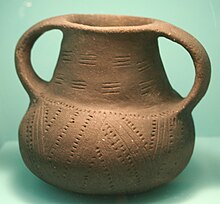Jordansmühler culture

The Jordansmühler culture (also Jordanów culture ) is a young Neolithic culture which marks the final phase of the Lengyel culture (Lengyel IV) in eastern Central Europe ( Silesia , Bohemia and Moravia ). The few settlement areas in Germany are connected to the Bohemian distribution area through the Elbe and are in the Dresden area , plus a site downstream in Wulfen ( Saxony-Anhalt ).
The term was introduced in 1906 by Hans Seger , after the Lower Silesian site of Jordansmühl near Breslau (now Jordanów Śląski , Poland). According to the main distribution centers, there is a Silesian and a Bohemian group.
Chronological classification
The predecessor of the Jordansmühler culture is the late Lengyel horizon in Bohemia. Dating from approx. 4,300-3,900 BC. It exists parallel to the Michelsberg culture . Successors are the funnel beaker culture (FN C or FN II) and the Baalberger culture in Central Germany.
Settlements
In the main distribution area, hill settlements dominate (e.g. Jevisovice), outside there is only one house finding from Wulfen, district of Köthen (Saxony-Anhalt). For the first time in northern Central Europe, independent copper processing has been proven, but not yet large equipment, but jewelry: pearls , pendants, spiral arm rings and glasses spirals.
Graves
In Silesia mostly OW-facing stool graves surrounded by stone packings . Women lie on the right, men on the left. Relatively common are grave decorations made of sheet copper (beads made from rolled sheet metal), as well as copper spiral arm rings and glasses-shaped double spirals; in addition, flint cuts and two to four vessels at the head end. Cremation dominates in Bohemia .
inventory
Tall, round-bottomed jug with one (Bohemia) or two (Silesia) handles at the edge. Rich decoration with incised or pierced meanders or angular bands (in Bohemia partly recessed angular band). In addition, there are also undecorated bowls with a high base, bowls with a curved rim, bent-rim bowls and amphorae.
The ram figure
The small clay sculpture of a ram by Jordansmühl is the focus of interest more than any other evidence of this culture. In 1925 she was recovered from a pit that is not connected to the eponymous burial ground. Two remains of a vessel and a fragment of a knife made of flint also lay in this pit. These additional finds prove the assignment to the Jordansmühler culture. The figure itself remains unique in Central European prehistory. The animal body is covered with rows of ornaments in string decoration. The design is perfectly harmonious. The figure got into the pit undamaged. So it was not disposed of, but apparently buried.
literature
- Joachim Preuss (Ed.): The Neolithic in Central Europe. Volume 1-3. Beier & Beran, Weissbach 1996-1999. (The individual cultures are described lexically in Volume 2.)
Individual evidence
- ↑ H. Seger: The ram of Jordansmühl. In: Yearbook for Prehistoric and Ethnographic Art (IPEK). 4, 1928, pp. 13-17.
